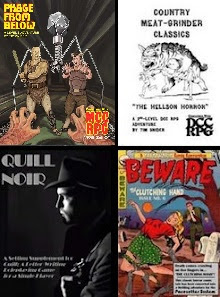Stumbled across this "system-neutral" post-apocalyptic setting created by the folks at Gamer Assembly...
In 3 Generations After The End, the Apocalypse re-introduced magic int the world. The sky collapsed. The sun vanished. The moon cracked. Waves plunged the cities into the sea. Airplanes fell from the sky. And the wizards, warlocks, and witches of olden times returned. (These may be related.) The wizards (which is what most people call those with magical ability) soon retreated into abandoned labs and created armies of strange beasts and beast-men. These creatures could not be controlled, and many still survive in bands around the world.
Wizards Are Powerful And Feared
Though quite a few low- to medium-powered wizards live scattered around the world, the public imagination views wizards as super-powerful, quasi-immortal beings who can mold reality to their will and rule their fiefdoms with absolute authority. Wizard-ruled kingdoms are usually theocracies, basically large and organized cults devoted to the will of the wizard ruling them. Those involved are rarely happy about this, but those who disobey are quickly discovered and sacrificed to demons (or worse things).
Techno-Priests Control the Cities
Within the crumbled cities of yore, the Priesthood has arisen to preserve the technology of the past. In some places, they are merely the preservers of vast archives of knowledge. In others, they subdue and rule the others who live in their cities, demanding tribute and sacrifices. The cities themselves are marginally safer than the wilderness, but hold unique dangers. Winged lizards nest on the roofs far above, while ratfolk scurry through the sewers. Old parks are now farms struggling to coax even mutated vegetables from the tired earth.
Savage Nature Abhors Technology
The deeper one presses into the wild forests and jungles of the world, the less technology functions. Vicious, powerful creatures live deep in the wild places. Rare is the non-wizard who can survive in the wilderness.
Regions Are Controlled By Wizards Or Warlords
Open, habitable spaces–the farmlands of old–are usually split up into small nation-states, each ruled by a wizard or a warlord. Technology has regressed to a subsistence level of food production, scavenging, and trade. Remnants of the old world are used for shelter and raw materials.
3 Generations After The End is a free download and is available at RPG Now.
Gammarauders (1987)
-
From the web:
Each player plays a large cybernetic creature known as a bioborg, which
wanders about a radioactive science fiction landscape. Bioborgs are...












































































.jpg)













